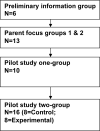Development and pilot testing of a parent education intervention for type 1 diabetes: parent education through simulation-diabetes
- PMID: 22222512
- PMCID: PMC3575091
- DOI: 10.1177/0145721711432457
Development and pilot testing of a parent education intervention for type 1 diabetes: parent education through simulation-diabetes
Abstract
Purpose: To purpose of the pilot study was to evaluate the use of a pediatric human patient simulator (HPS) to teach parents diabetes management for their children newly diagnosed with type 1 diabetes, referred to as Parent Education Through Simulation-Diabetes.
Methods: A focus group study and 2 pilot studies (1-group study and a randomized 2-group study) were used to develop and test a teaching intervention. Parents were recruited from the Pediatric Diabetes Clinic at UMass Memorial Medical Center. A brainstorming group (n = 6) discussed the simulator concept and what modifications would be necessary to enhance parent teaching; the authors also developed the initial hypoglycemia and hyperglycemia teaching vignettes. Two focus groups (n = 13) discussed the acceptance of using a simulator and the timing and content of the teaching sessions. Based on their recommendations, a 1-group pretest-posttest pilot was conducted with parents (n = 10) receiving hypoglycemia education enhanced with the HPS, followed by a randomized 2-group pilot study (n = 16). Findings The focus group participants enthusiastically supported the use of the pediatric HPS after diagnosis and made recommendations for the timing and content of the teaching sessions. Major findings from the pilot work included (1) successful recruitment of 16 participants from only 1 site within 6 weeks, (2) instrument reliability demonstrated for all scales, and (3) mean change from baseline in the predicted direction for all measures.
Conclusions: The HPS has the potential of providing parents an innovative means of learning diabetes management through visualization during the early months after diagnosis and so warrants a powered study to determine its efficacy.
Figures
Similar articles
-
PETS-D (parents education through simulation-diabetes): Parents' qualitative results.Patient Educ Couns. 2016 Aug;99(8):1362-7. doi: 10.1016/j.pec.2016.03.019. Epub 2016 Mar 19. Patient Educ Couns. 2016. PMID: 27021779 Free PMC article. Clinical Trial.
-
CDE Perspectives of Providing New-Onset Type 1 Diabetes Education Using Formal Vignettes and Simulation.Diabetes Educ. 2017 Feb;43(1):97-104. doi: 10.1177/0145721716676893. Epub 2016 Nov 15. Diabetes Educ. 2017. PMID: 28118129
-
PETS-D: Impact on Diabetes Management Outcomes.Diabetes Educ. 2015 Oct;41(5):537-49. doi: 10.1177/0145721715598383. Epub 2015 Aug 5. Diabetes Educ. 2015. PMID: 26246593 Clinical Trial.
-
Preteen-parent experiences with PREP-T1 feasibility intervention.Diabetes Educ. 2015 Aug;41(4):452-8. doi: 10.1177/0145721715587743. Epub 2015 May 25. Diabetes Educ. 2015. PMID: 26009556
-
Interventions to Promote Diabetes Self-Management in Children and Youth: A Scoping Review.Am J Occup Ther. 2016 Sep-Oct;70(5):7005180020p1-8. doi: 10.5014/ajot.2016.021618. Am J Occup Ther. 2016. PMID: 27548858
Cited by
-
Revisiting a non-significant findings study: a parent mentor intervention trial as exemplar.Appl Nurs Res. 2014 Nov;27(4):213-8. doi: 10.1016/j.apnr.2014.02.001. Epub 2014 Feb 10. Appl Nurs Res. 2014. PMID: 24661347 Free PMC article.
-
PETS-D (parents education through simulation-diabetes): Parents' qualitative results.Patient Educ Couns. 2016 Aug;99(8):1362-7. doi: 10.1016/j.pec.2016.03.019. Epub 2016 Mar 19. Patient Educ Couns. 2016. PMID: 27021779 Free PMC article. Clinical Trial.
-
Description and preliminary evaluation of a diabetes technology simulation course.J Diabetes Sci Technol. 2013 Nov 1;7(6):1561-6. doi: 10.1177/193229681300700616. J Diabetes Sci Technol. 2013. PMID: 24351182 Free PMC article.
-
"This Is How Hard It Is". Family Experience of Hospital-to-Home Transition with a Tracheostomy.Ann Am Thorac Soc. 2020 Jul;17(7):860-868. doi: 10.1513/AnnalsATS.201910-780OC. Ann Am Thorac Soc. 2020. PMID: 32267725 Free PMC article.
-
Interactive media for parental education on managing children chronic condition: a systematic review of the literature.BMC Pediatr. 2015 Dec 3;15:201. doi: 10.1186/s12887-015-0517-2. BMC Pediatr. 2015. PMID: 26634913 Free PMC article.
References
-
- IDF Diabetes in children: epidemiology. Pediatric Diabetes. 2007;8(Supplement 8):10–8.
-
- Wennick A, Hallstrom I. Swedish families' lived experience when a child is first diagnosed as having insulin-dependent diabetes mellitus. Journal of Family Nurisng. 2006;12(4):368–9. - PubMed
-
- Sullivan-Bolyai S, Bova C, Leung K, Trudeau A, Lee M, Gruppuso P. Social Support To Empower Parents (STEP): An intervention for parents of young children newly diagnosed with type 1 diabetes. The Diabetes Educator. 2010;36:88–97. - PubMed
-
- Ten Ecyk RP, Tews M, Ballester JM. Improved medical student satisfaction and test performance with a simulation-based emergency medicine curriculum: A randomized controlled trial. Ann Emerg Med. 2009 - PubMed
Publication types
MeSH terms
Grants and funding
LinkOut - more resources
Full Text Sources
Medical


